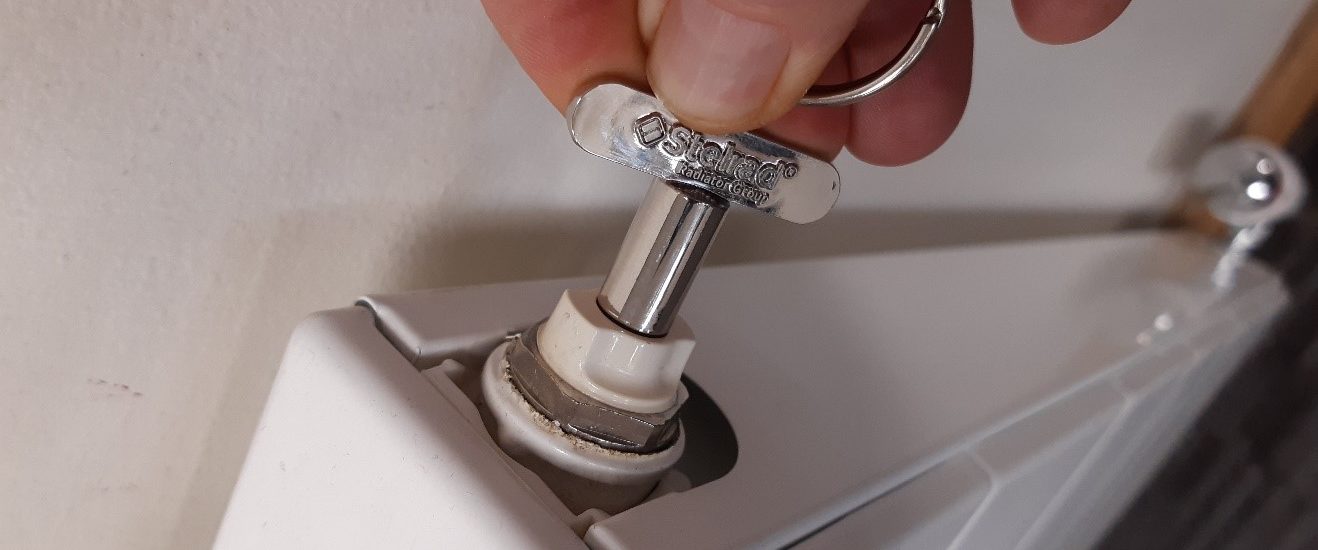Radiator not working after being bled
Bleeding (also known as venting) is a common solution to cold spots in your radiators. You should do it semi-regularly and at a minimum of once a year. Ensure you bleed the radiator
completely so that there’s no trapped air inside.
You may wonder ‘when bleeding radiators should the heating be on’? It’s important to ensure your central heating system is turned off and your radiators are cold before attempting to bleed them. When on, radiators will contain hot water that could scald you if it sprays or leaks out.
You may still find your radiator’s not working after bleeding. Here are a few quick checks that you can do to see if there’s an easy solution. If you’re still having trouble, we recommend you contact an expert.
Inspect your TRV
The first thing you should do is check the TRVs (thermostatic radiator valves) on your radiators. Check if the TRV has a pin stuck in the closed position. You’ll need to take the head or cap off the TRV and look for the pin. If it is stuck, grab some mole grips or pliers to grip the pin and lift it up and down to loosen it. Make sure not to prise the pin entirely loose as you’ll end up with water spraying everywhere. This should help get hot water flowing through your system again. Replace the cap and turn your radiator on to see if it heats up properly.
If a stuck pin isn’t the problem, it might be time to replace the TRV. We recommend doing so every 10 years on average.
Flush your radiator
Over time, your radiator will get a build-up of any dirt and scale. This sludge will circulate the system and could prevent the hot water circulating properly. You may find that the radiator feels cold at the bottom, which indicates you need to flush your radiator.
You can flush the radiator in under two hours. To do this ensure the heating is switched off and remove the radiator from the wall. Lay down an old towel or sheet (they will get messy) and turn off the lock shield valve and the TRV. Grab a bucket and put it under the TRV, before using the bleed key to open the bleed valve to release the water and sludge. Once the radiator is clear, disconnect the radiator entirely, take it outside and flush it through with a garden hose. You can do this by putting the hose into the pipe inlet. The radiator can now be reconnected.
Balance your Radiator
Balancing your radiator ensures there is an even distribution of hot water throughout the radiators in your home. If your radiators are unbalanced, they won’t heat up at the same time as each other.
To balance your radiator, you’ll need to turn off the central heating and open the radiator valves. Turn your heating back on and time how long it takes each radiator to heat up. Take measurements with a digital thermometer or multi-meter with thermometer. You’ll need to check the temperature of the pipework leading to one of the valves and then the other. Then, gradually turn the lock shield valve until the difference between the readings of the two pipes is 10°c exactly. Make sure to wait for the temperature change every time you turn the lock shield valve to get an accurate reading. Continue balancing the other radiators in your home the same way.
If you’re still having trouble, we recommend you contact an expert.
Do you need radiators with underfloor heating?
Getting underfloor heating is very expensive compared to installing radiators. However, if you want to try out underfloor heating, you could always combine the two so that you’re not paying to get the whole property done in one go. The two heating systems can work well together if you want to keep some radiators. Underfloor heating can be installed alongside an existing radiator system.
Contact us
Bleeding your radiators should be part of your regular property maintenance. You should do it at least once a year. However, you may find your radiator not getting hot even after bleeding. We suggest you try the above suggestions to see if there’s a simple issue with your radiators. You can contact us if you have any questions about your radiators or feel it’s time to replace them.

